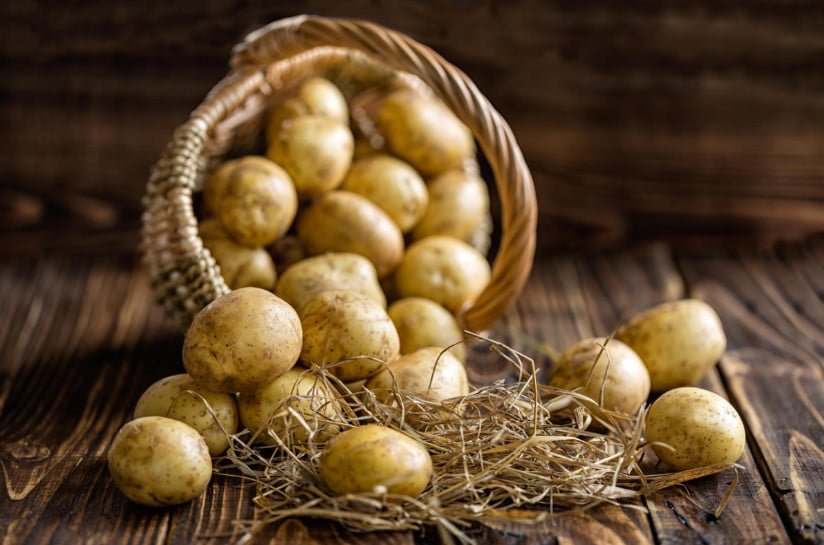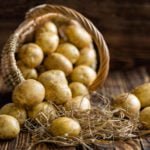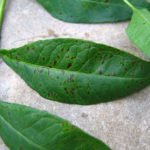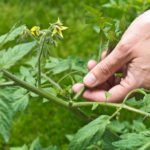All healthy potatoes are similar to each other, but each rot in its own way. Every year a “not potato” is produced: drought without the rain, somewhere in the rain and cloudy all summer. And everywhere, under completely different weather conditions, potatoes rot.
Rot can be divided into certain groups, the nature of the disease in each of them is its own, individual. According to surveys of neighbors, friends and relatives, after analyzing the information on the Internet and the questions of gardeners on our website, we can identify the main potato problems faced by gardeners:
- instead of tubers in the nest wet mass unpleasant smelling rot. It has to be collected by handfuls or a shovel;
- potatoes from the nest is removed externally quite healthy, but begins to deteriorate almost before our eyes. Someone during the dry tubers are already visible spots of rot, these can (and should!) select for destruction. Others for a longer time, a significant part of the tubers changes appearance-rot appear. We have potatoes, laid down for storage, to sort out again — this time in the cellar or the basement because you can not procrastinate to rot quickly.
This is the most severe cases. It is clear that not only the weather is to blame, it is only a predisposing factor. It is clear that in the soil there are people harmful to potatoes, who destroy the harvest not only in the field, but also in storage areas. What to do to avoid diseases in the new garden and country season? First, to understand-what causes harm. And then figure out how to deal with it.
What are the diseases of potatoes
In 2015, in the surveyed area from one hectare on average collected 21 tons of potatoes. A little? A lot? The estimated potential productivity of most varieties exceeds 50 tons per hectare — the opinion of experts.
Diseases are one of the reasons for low yields. Very much like the pathogens of tubers and tops, because they have a lot of carbohydrates. Almost thirty diseases attack our potatoes. The trouble is that potatoes are propagated vegetatively, that is, tubers. They are the source of infection, it is then the disease appear on the stems, leaves, stolons. Pathogens persist in the soil.
Infectious disease
They are transmitted from plant to plant. They are caused by fungi, bacteria, viruses. Each microorganism manifests itself differently on the plant — like human flu: it seems that the temperature and runny nose are in any case, but the onset of the disease is not the same.
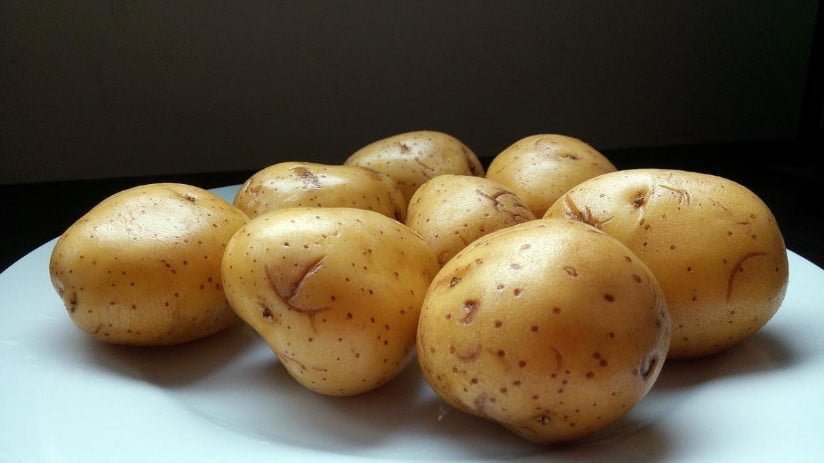
Potato diseases can be detected by signs. For example, when drooping stems and leaves, you can suspect that bacteria or mycelium of fungi clogged conducting vessels. Or die areas on the leaves and stems — they are called spots. Sometimes the tissues are softened — then talking about rots.
Noncommunicable diseases
They are not transmitted from plant to plant. External signs indicate a lack or surplus of nutrients, water, temperature (for example, after a light freeze or heat). This also reduces the yield.
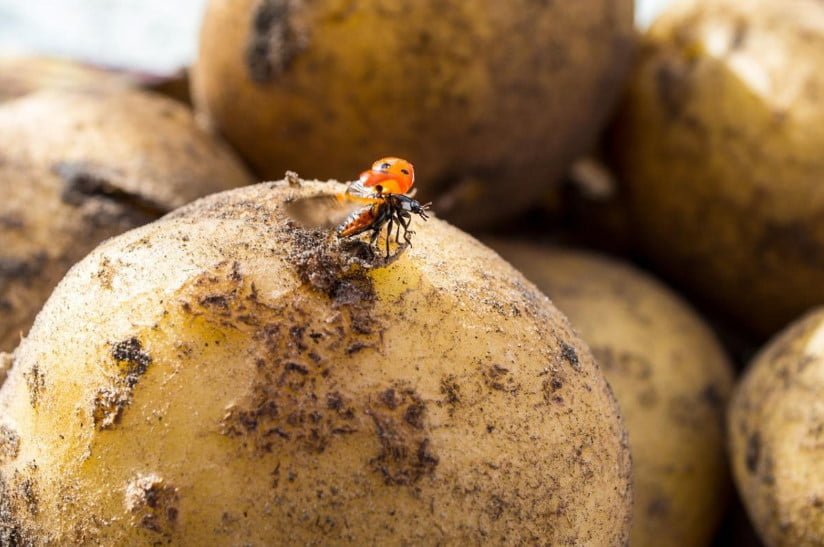
If you remove all the harmful factors, the manifestations of diseases disappear.
What causes disease
Mushrooms. To feed on the plant, they need to infiltrate it-in this initial period is not a specialist disease is difficult to detect. To capture a large area, the fungi need to throw spores on the surface — that’s when well visible spots of all kinds and colors, a kind of spraying on them, that is, changing the structure of plant tissues.
There are mushrooms that can live only on one plant, for example, the causative agent of powdery scab and potato cancer. Others are able to parasitize on several plants. With rare exception, the mushrooms are “love” acidic soil, planting does not agronomically certain periods, the lack of nutrients in the soil, delayed the timing of all of the types of care for potato crops.
Bacteria. Those that affect the root or vascular system, destroy the plant. Others do not ruin, but the damage from them can be very serious.
Externally, bacteriosis can be divided into rot, wilting, growths (tumors), burns, necrosis. And yet — actinomycetes, which cause common scab.
Fungal diseases of potatoes
Late blight. It is considered the most common and harmful disease, because its development is rapid. If the conditions for the life of Phytophthora are suitable, then after the detection of the first single source of infection, without taking measures to protect, in three weeks the entire potato field will die. Phytophthora changes skillfully. Earlier, the first foci were found closer to the harvest time, now — during the closure of the tops, and sometimes before. And the temperature corridor has expanded: the period, which can be called drip, has decreased almost twice. Because the risk of tuber disease is high.
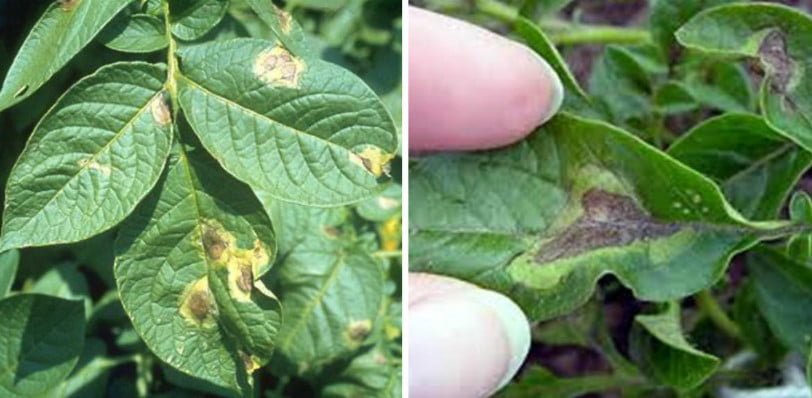
What does the sick plant look like: the place where the parasite penetrates the plant (often the upper leaves) becomes noticeable after about four days. This spot, which has no clear boundaries, it is vague, the color is brown. On the stems elongated.
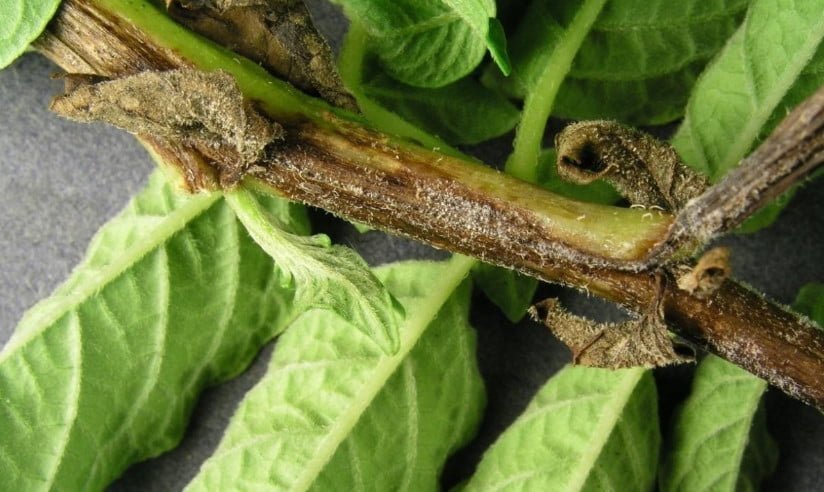
In the morning, when the humidity is higher (or in rainy weather), on the inside of the sheet you can find a white plaque, it is located on the border of the affected and healthy tissue. If the weather is dry, the tops dry up, becoming brown and brittle. If it rains and the humidity is high, the tops begin to rot.
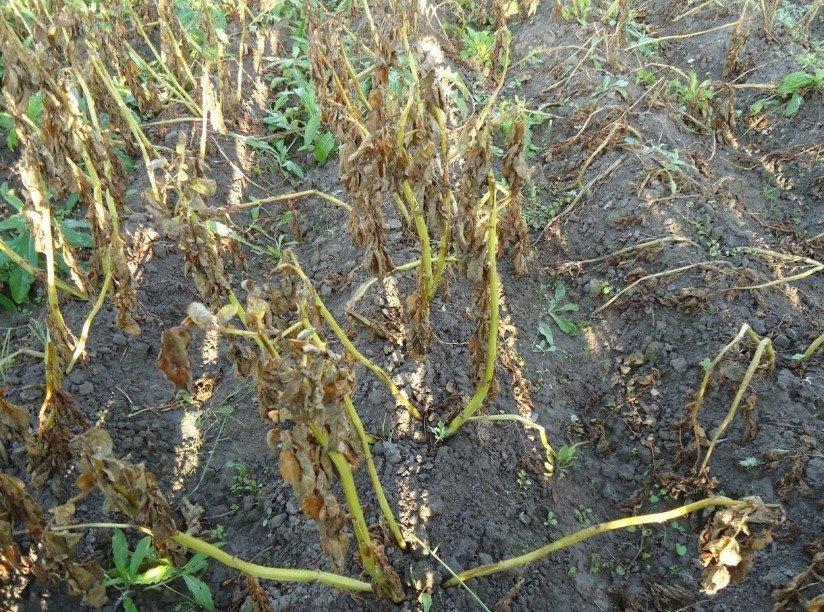
Tubers can be infected from the very beginning of their formation and before harvesting, introduction occurs in lentils and through damage to the rind that make nematodes, wireworms. The spots on the tubers are a little dented, hard, brownish-gray.
Places of defeat Phytophthora-the gate to the penetration of bacteria, the cause of rot in the cellars of tubers and basements during storage. In the collage you can see how the Phytophthora affects the organs of the plant.
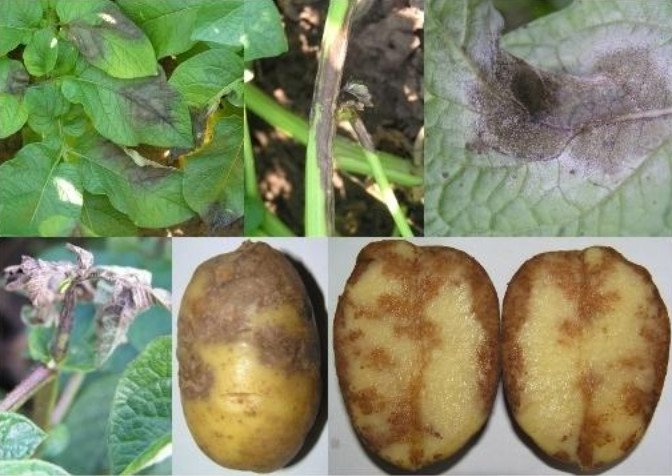
In our country, the infection winters on tubers in storage, the opportunity to survive the winter in the soil on the remains of plants is negligible. Storage lay apparently healthy tubers which are actually just slightly infected. If the potato is removed in the early stages, yet his skin is not Mature and does not become dense, the infection occurs.
Anthracnose is a disease of hot and dry summer. More common in early maturing varieties and weak specimens. All parts of plants are affected: stems, stolons, roots, tubers.

The disease is determined in the second half of the growing season. First, the upper leaves turn yellow, curl along the Central vein, wither and die. On the stems, first in the lower part (at the place of attachment of the petiole leaf to the stem), there are light spots, slightly pressed into the fabric.So, gradually lowering, the whole plant dies.
In humid wet weather the sore spots start to rot, lose their shape, becoming similar to urine. Then there is a slimy black plaque. Even when dry, these places are clearly visible. If the weather is dry, the stems dry, begins to exfoliate the top layer.
On all underground parts of the visible surface rot of the upper epithelial tissues of the plant. It becomes noticeable change in color, palette ” lilac-pink-amethyst.” Infection of tubers occurs at the place of attachment of stolons. There’s a depressed spot. Tuber rots, turning into a foul-smelling mucous mess. It seems that it is sometimes dug out of the nest of gardeners, collected in buckets and carried out from the field. However, infected tubers enter the storage. Sometimes they become rotten, if you press on the tuber, it falls apart. Possible annular necrosis is seen in a transverse cut. If you plant these tubers, then either it will be sick plants, or they do not germinate.
Vertical withering. There are two ways for a plant affected by wilt. The first is to die quickly if the conditions are favorable for the development of the disease. The second is a long time to be sick. That is, to fade, starting to turn yellow from the lower leaves, which are then twisted, sometimes keeping green only the upper parts of the stems. In hot weather, twisting begins before the withering, they look like they are scalded.
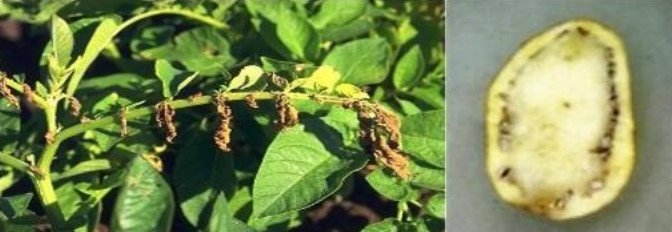
The disease appears at the end of flowering. If the weather is wet, then in the affected parts visible plaque ugly dirty gray or dirty pink. On tubers, the eyes are rotting. During storage, this rot seems to dry out, turning almost into dust. Instead of eyes remain hollow. But the signs of the disease are not always visible. Because the tubers are planted in soil they grow sick of the bushes.
This is not all diseases, to be continued…
